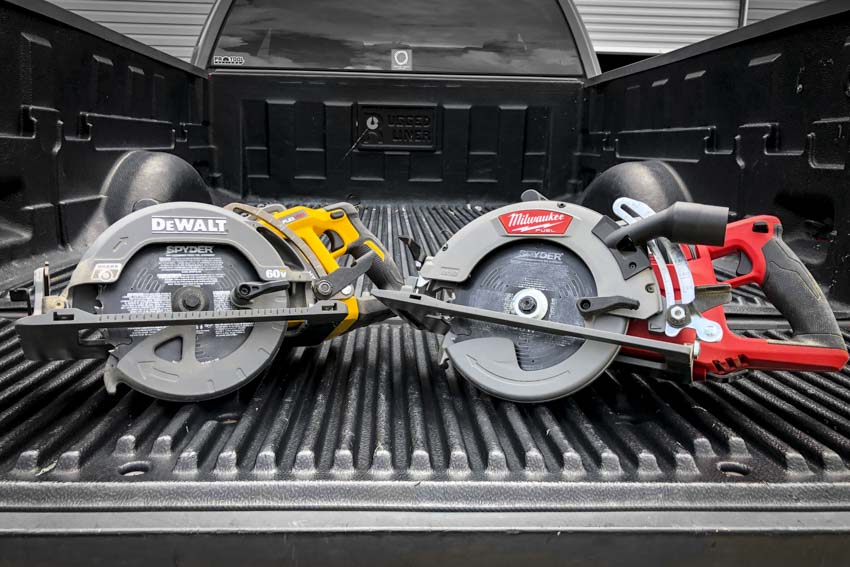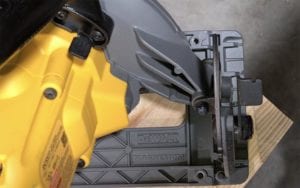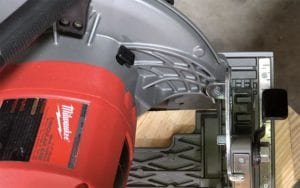Our Experts Test Two of the Highest-Scoring Cordless Circular Saws Head-to-Head
Both the DeWalt FlexVolt Worm Drive Style and Milwaukee M18 Fuel Rear Handle circular saws are in the upper tier of what cordless tools have to offer. They use advanced batteries, motors, and electronics packages to deliver much higher performance than standard cordless tools can give you.
They’re rear-handle, or worm drive style, designs. They’re not true worm drives in their gearing but they carry the style, including using diamond instead of round arbors. We typically see this style of saw on the west coast and they’re known for having higher torque for long rip cuts in multiple layers of sheet goods.
DeWalt FlexVolt Worm Drive Style Vs Milwaukee M18 Fuel Rear Handle Circular Saw on Paper
DeWalt FlexVolt Worm Drive Style
The DeWalt FlexVolt Worm Drive Style circular saw, the DCS577, uses FlexVolt battery technology. It’s a battery that can detect when to run at 20V max and when to run at 60V max depending on the tool you attach it to. It gives DeWalt’s more power-hungry tools such as circular saws, table saw, miter saws, and others the ability to run at a higher voltage without completely departing from compatibility with the 20V max system.
- Voltage: 60V Max (54V nominal)
- Blade Size: 7 1/4-inch
- Blade Orientation: Left
- No-Load Speed: 5800 RPM
- Bevel Capacity: 53º
- Cutting Depth at 90º: 2 7/16 inches
- Cutting Depth at 45º: 1 7/8 inches
Read our full review here.
Milwaukee M18 Fuel Rear Handle Circular Saw
The Milwaukee 2830 M18 Fuel Rear-Handle circular saw still runs at 18V, but it has an upgraded PowerState brushless motor and electronics dialed in to pull more power from Milwaukee’s High Output batteries. These packs are able to deliver more power to the tool than Milwaukee’s standard M18 batteries.
- Voltage: 18V
- Blade Size: 7 1/4-inch
- Blade Orientation: Left
- No-Load Speed: 5800 RPM
- Bevel Capacity: 53º
- Cutting Depth at 90º: 2 1/2 inches
- Cutting Depth at 45º: 1 7/8 inches
Read our full review here.
DeWalt FlexVolt Worm Drive Style Vs Milwaukee M18 Fuel Rear Handle Circular Saw Testing
Circular saws make two basic kinds of cuts, cross cuts and rip cuts. There are variations on that with bevels and miters, but they all start with the same foundation.
The first thing we had to do was get set up for our tests. We want to mimic real-world conditions as much as possible, but we also want to keep the materials as consistent as we can. Knots, density, and moisture can all make cuts vary from one board to the next. So we use a combination of 3/4-inch OSB subfloor and pressure-treated 2x in different tests.
Before we got started, we swapped out the stock blades out for Spyder 7 1/4-inch framing blades so they’re using the same kind and made sure the batteries were fully charged.
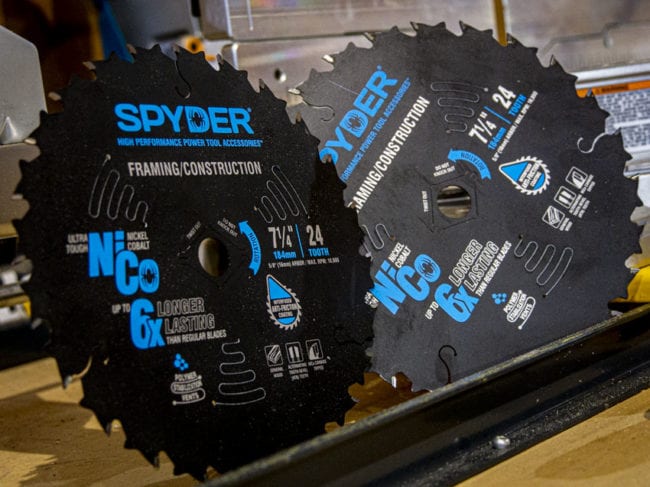
Cutting Power
For our first test, we wanted to see which saw has better power. We clamped up two sheets of OSB and ran both saws across the short side to see which one we could push harder without bogging.
DeWalt might have a higher voltage, but Milwaukee’s High Output battery evens the playing field by allowing more current to reach its brushless motor. After running both saws, it was tough to tell if one was clearly ahead of the other. I thought DeWalt had a slight advantage while Clint felt Milwaukee had the edge.
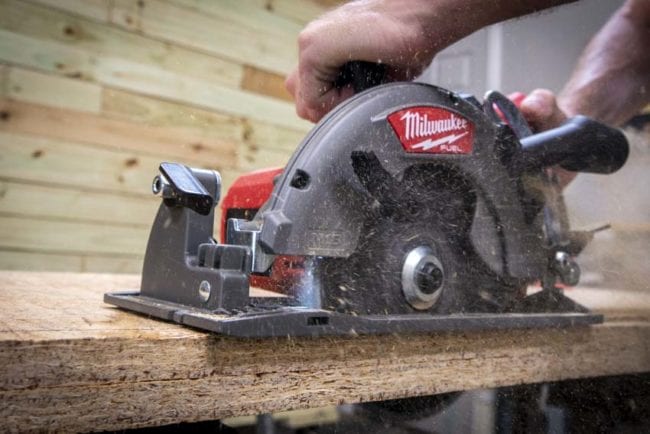
Either way, it’s clear that both of these saws are in the top tier of the power you can get from a cordless circular saw. With that decided, we moved onto dust and chip removal.
Dust and Chip Removal
Dust and chip removal is important to help keep your cutline clear. If you can’t see your cutline, you can’t make an accurate cut. We used a straightedge to make lines on a single sheet of OSB and then cut freehand to see how well these two saws keep it clean.
Both saws left a little bit of debris around the line but we really couldn’t tell if one was better than the other. The combination of ejection and cutline blowers did a great job for both.
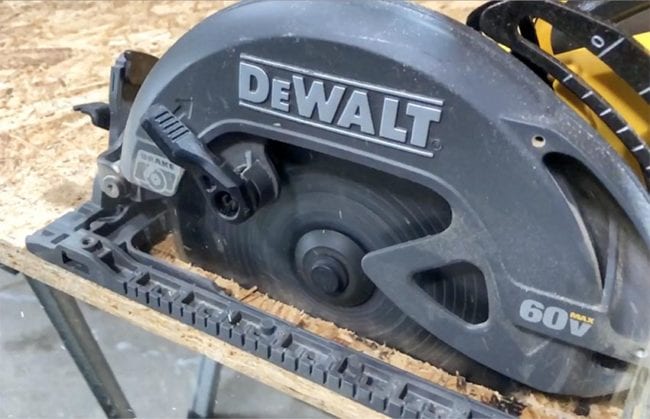
Clint was quick to point out why he prefers a blade-right saw, though. As right-handed users, the blade left design dumps sawdust toward you while you cut.
A little sawdust doesn’t bother me as much and I prefer blade-left for my sightlines.
Both saws have dust port vacuum adapters, and that completely changes the game if you’re cutting inside or you’re trying to contain the mess. Using a vacuum doesn’t just keep the cutline clear, it eliminates 90% or more of the mess you’d have to clean up later.
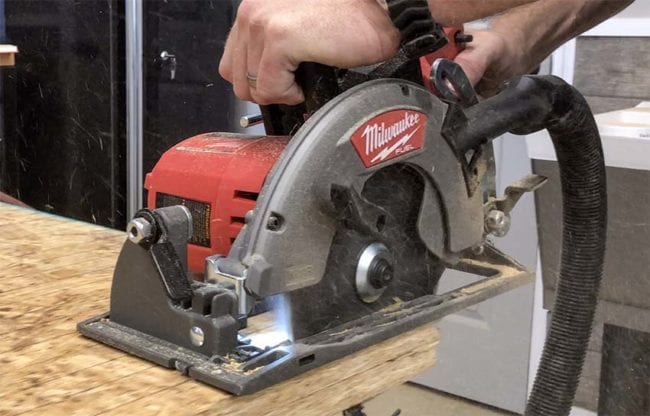
With as much work as we do in our shop, using a vacuum with our circular saws is a big timesaver at the end of the project when we’re wrapping up for the day.
Of course, we were far from finished testing at that point and accuracy was next on the list.
Accuracy
Our accuracy test consists of three parts: sightline to the blade, the accuracy of the notches in the shoe, and how well the saw tracks.
Milwaukee had perfect scores in all three tests. It’s got an obstruction-free sightline to the blade from both sides, the notches were dead on with our blade at both 0º and 45º, and the handle design doesn’t encourage you to push right or left away from your cutline.
DeWalt also did really well in our accuracy tests. Like Milwaukee, it had perfect scores for its shoe notches and tracking.
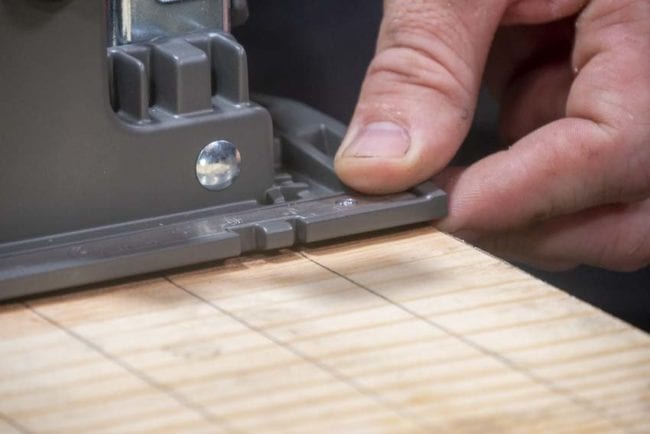
But its sightline to the blade isn’t quite as clear as Milwaukee’s if you’re looking in from the right. It’s still effective, but you might have to adjust your head a bit if you prefer to follow the blade’s contact with the line instead of using the shoe notches.
Movement
There are two things we check on the saw’s movement. The most important is how smooth the guard action is on a wide variety of cuts. The other is how much friction the shoe has as it glides over the wood you’re cutting.
DeWalt’s guard action smoothly lifted over nearly every cut we made: cross cuts in 2x and 3/4-inch material, shave cuts, miters, bevels, and compound cuts. There was just one compound cut the guard hung up on.
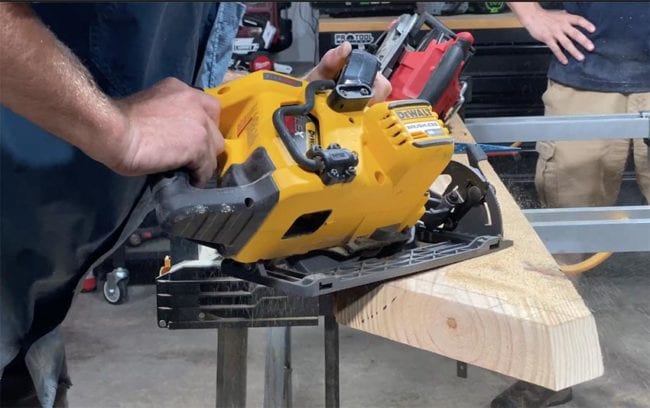
Milwaukee matched DeWalt cut for cut on its guard action but didn’t hang up on any of them. While it’s a really close race, Milwaukee’s perfect score here is a little better.
On the other hand, shoe friction is a sticky situation for DeWalt. The sidewinder version of the FlexVolt circular saw didn’t glide very well in its tests. The Worm Drive Style is a little better, but it’s not great. We’ve even seen some guys in the field sand the base a little to improve its glide.
Milwaukee’s Rear Handle saw doesn’t have the friction DeWalt does. It’s a much smoother glide. We’ve tested other saws that are better, but the M18 Fuel Rear Handle is very close to the top.
Ergonomics
It’s arguable how much weight comes into play with a circular since it’s not as typical to cut vertically or overhead. Still, you have to haul your circular saw around, so the lighter, the better.
Neither one of these saws comes in as light as most sidewinder styles and the large batteries don’t help matters much. Milwaukee’s M18 Fuel is 10.3 pounds bare and a hefty 13.7 pounds with its 12.0Ah High Output battery.
DeWalt is pretty close to Milwaukee’s weight. It’s 10.5 pounds bare and its 3.0/9.0Ah battery brings it up to 13.7 pounds. If you want to use the 4.0/12.0Ah battery, it’ll be a bit more.
As corded replacements, the weights aren’t way out in left field, though. Our corded worm drives weigh up to 14.2 pounds, and both Milwaukee and DeWalt come in about a half-pound under that.
Looking at handle ergonomics, the two saws are nearly identical in their shape and overall rear-handle design. Even though they’re really similar, we like DeWalt’s handle ergonomics better with its secondary handle having a larger, more comfortable shape than Milwaukee’s more traditional skinny handle.
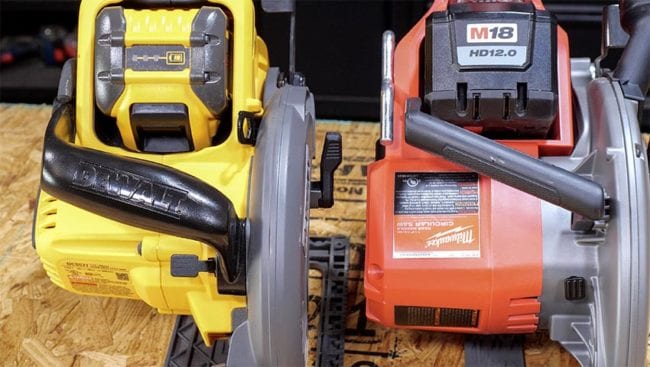
Feature Sets
When it comes to features, both saws check off a lot of the same boxes: advanced brushless motors, blade brakes, LED lights, cutline blowers, and rafter hooks.
Milwaukee includes its vacuum adapter while DeWalt doesn’t, though. You have to pick it up separately.
DeWalt’s multi-voltage battery also works in all of their 20V max tools, so you get some cross-compatibility between the lines. You can’t run a 20V Max battery in this saw, though.
Milwaukee doesn’t need a different voltage to reach its higher power level, so all of its batteries work in all of its M18 tools, including their advanced models. However, you only get the best performance when you use a Milwaukee High-Output battery. We suggest you only plan on using a standard M18 pack with this saw in a pinch.
MX Fuel is a different compatibility story, and those tools are targeting a completely different set of equipment.
Price and Value
So let’s talk about price and value. Milwaukee’s M18 Fuel runs $269 as a bare tool and $449 with a 12.0Ah High Output battery and charger.
DeWalt’s FlexVolt will set you back $249 as a bare tool and $399 with a 3.0/9.0Ah battery and charger, making it a little less expensive, even though it doesn’t have as large of a battery in the kit.
Milwaukee gives you better warranty coverage with their 5-year plan while DeWalt settles in with a 3-year warranty and 1-year service agreement.
Both brands run deep in the cordless market, but there’s a big difference between the number of M18 tools and the number of FlexVolt tools. You can only run FlexVolt tools on FlexVolt batteries, so the line is more limited than Milwaukee’s.
Again, you get the best performance from Milwaukee’s advanced 18V tools only when you use their High-Output battery. That’s something to keep in mind.
We punched everything into our value algorithm, and both saws offer a good value in this upper tier, but Milwaukee did edge out DeWalt by a couple of points.
The Bottom Line
DeWalt vs Milwaukee is one of the heavyweight battles in the power tool industry right now and testing the best cordless circular saws from both of them leaves us believing there’s not really a loser between the two considering they’re two of the highest-scoring models we’ve tested.
But we did keep score.
And when we added everything up, Milwaukee’s M18 Fuel Rear Handle saw edged out DeWalt’s FlexVolt Worm Drive Style by a single point. That’s a really close finish and terrific scores for both models.
What do you think? What tools would you like to see us test head-to-head? Let us know in the comments below and as always, thanks for reading!

